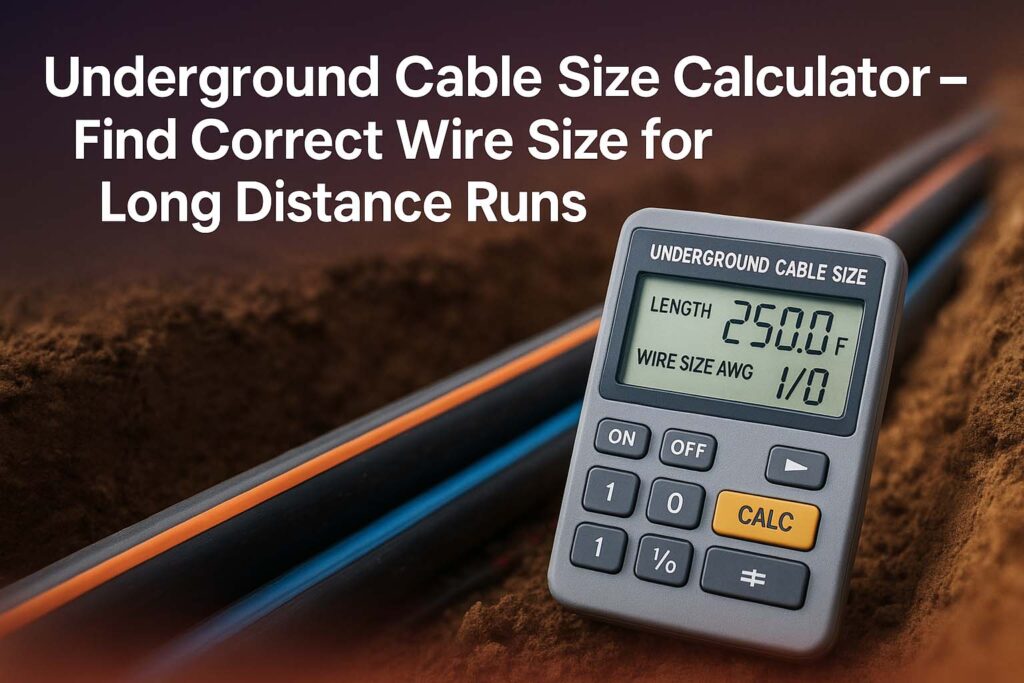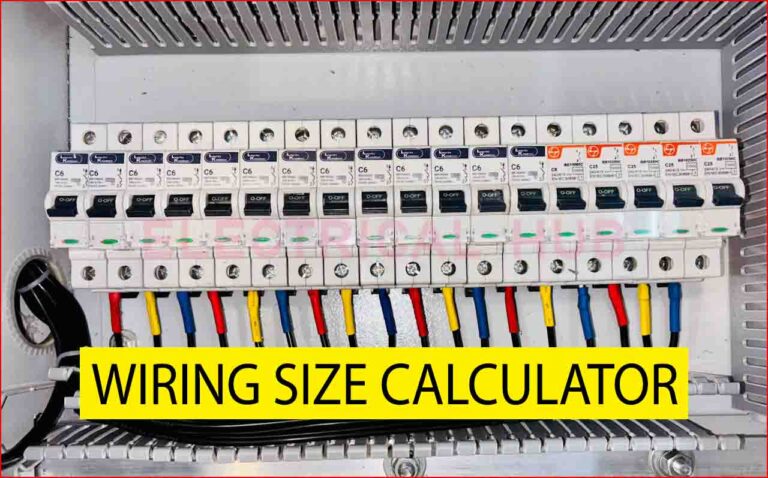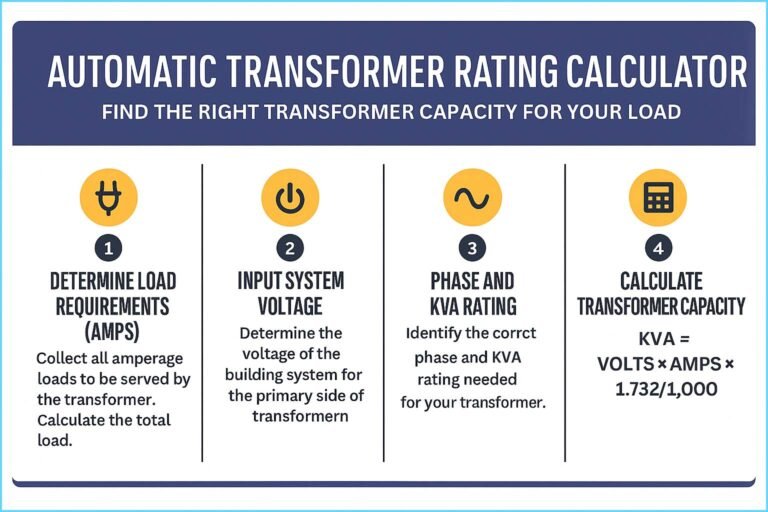Underground Cable Size Calculator – Find Correct Wire Size for Long Distance Runs
Underground wiring is essential for modern infrastructure. It offers better aesthetics, safety from environmental damage, and fewer maintenance needs compared to overhead lines. But one critical aspect of planning underground electrical wiring is choosing the correct cable size. That’s where an Underground Cable Size Calculator becomes a vital tool.
Table of Contents
Table of Contents

Whether you’re powering a pump in a distant field, lighting up an outdoor facility, or running power to a shed, using the wrong cable size can lead to voltage drop, overheating, and wasted energy. This detailed guide will help you understand the technical considerations behind cable sizing and how an underground cable size calculator simplifies the process.
Why Use an Underground Cable Size Calculator?
When electricity travels through a cable, some voltage is lost due to the resistance of the conductor. The longer the distance, the higher the loss. An Underground Cable Size Calculator helps you find the correct cable gauge that minimizes voltage drop while remaining cost-effective.
Underground installations differ from above-ground wiring because they are subject to soil temperature, insulation de-rating, and installation method. That’s why manual guesswork often leads to dangerous errors. A calculator automates this, considering all relevant variables.
Use free online tool What Gauge Wire Do I Need?
Factors Considered by Underground Cable Size Calculator
An Underground Cable Size Calculator takes several parameters to determine the right wire size. Let’s look at the main factors:
1. Load Current (Amps)
The higher the current, the larger the wire size needed. Load current is based on the total power requirement in watts or kilowatts.
2. Voltage Drop Limit
For long-distance runs, voltage drop must be limited to avoid appliance damage. Typical voltage drop limits are:
- 3% for lighting circuits
- 5% for power circuits
3. Cable Length
Cable length in meters or feet affects how much voltage is lost during transmission. Double the length for single-phase systems, since current travels both to and from the load.
4. System Voltage
Whether the system is 120V, 240V, 415V or higher. Higher voltage systems can transmit the same power using smaller wires.
5. Phase Type
Single-phase or three-phase power affects current calculations and wire size selection.
6. Cable Type and Insulation
Underground cable insulation types (PVC, XLPE, SWA) have different current-carrying capacities and de-rating factors.
7. Soil Thermal Resistivity
Soil condition impacts how well heat is dissipated. Dry or rocky soils may require thicker cables to handle the same load safely.
Use free online tool NEC Wire Size Calculator
Understanding Voltage Drop with Distance
Here’s a simplified formula:
Voltage Drop (V) = (2 × L × I × R) / 1000
Where:
- L = one-way length in meters
- I = current in amperes
- R = resistance per kilometer of conductor (ohms/km)
Use this formula for single-phase systems. For three-phase, replace 2 with √3.
Let’s apply this in a quick example.
Example:
A single-phase pump is placed 150 meters away. It draws 20 amps on a 240V supply. The resistance of the chosen 10mm² copper cable is 1.83 ohms/km.
Voltage Drop = (2 × 150 × 20 × 1.83) / 1000 = 10.98V
That’s a 4.57% drop, which is acceptable for a power circuit. But for sensitive lighting loads, a thicker wire would be required to stay under 3%.
Common Underground Cable Sizes and Current Ratings
| Cable Size (mm²) | Current Capacity (Single Phase, PVC) | Approximate Voltage Drop (per 100m, 20A Load) |
|---|---|---|
| 2.5 mm² | 24 Amps | ~14V |
| 4 mm² | 32 Amps | ~8.5V |
| 6 mm² | 40 Amps | ~5.7V |
| 10 mm² | 65 Amps | ~3.5V |
| 16 mm² | 87 Amps | ~2.2V |
| 25 mm² | 114 Amps | ~1.4V |
The table shows how increasing the wire size reduces voltage drop, even for the same load.
Know more about Off-Grid Solar System Design Guide for Remote Areas
Using an Underground Cable Size Calculator – Step by Step
Here’s how you typically use an Underground Cable Size Calculator:
- Select System Type: Single-phase or three-phase.
- Enter Load Power or Current: You can input watts, kW, or amps.
- Input Cable Length: One-way distance.
- Choose Voltage: Standard options like 120V, 230V, 400V.
- Set Voltage Drop Limit: 3%, 5%, or custom.
- Pick Cable Material: Copper or aluminum.
- Specify Cable Installation: Underground duct, directly buried, etc.
- Get Result: Recommended cable size with calculated voltage drop.
Use free online tool Solar System Sizing Calculator for Agriculture & Tubewells
Why Not Oversize Every Cable?
While larger cables reduce voltage drop, they also increase costs. Oversizing by a huge margin means:
- Higher upfront material costs
- Difficult installation due to stiffness
- Waste of conductor material
- Risk of poor jointing or termination due to large diameters
An Underground Cable Size Calculator helps strike the perfect balance between cost, performance, and safety.
Benefits of Using Underground Cable Size Calculator
- Time-Saving: No need to refer to bulky electrical tables or do manual calculations.
- Accurate: Takes all de-rating factors into account.
- Safety: Ensures proper cable size to avoid overheating and fire risks.
- Optimized Cost: Avoids unnecessary oversizing of conductors.
- Regulatory Compliance: Helps meet local code and voltage drop limits.
Use free online tool Online Wire Gauge Calculator for 1 Phase and 3 Phase Load
Tips for Long Distance Underground Wiring Projects
- Use XLPE Insulated Cables: They offer better thermal performance than PVC.
- Bury Cables in Conduit: Especially in rocky or corrosive soils.
- Mark the Route: Use caution tape above the buried cable to prevent accidental digging.
- Install Earth Rods: Ensure proper grounding for safety.
- Check Local Codes: Always comply with NEC or IEC standards.
Underground Cable Installation Considerations
Besides size, installation conditions play a major role in cable life and efficiency:
- Depth: Bury cables at least 18 inches deep (more for high-voltage or road crossings).
- Backfill: Use sand or screened soil around the cable to avoid sharp object damage.
- Conduit Size: Leave enough room for heat dissipation and possible future upgrades.
- Drainage: Prevent water accumulation around cables to avoid insulation degradation.
Know more about Off-Grid Solar System Design Guide for Remote Areas
Conclusion: Make the Smart Choice with an Underground Cable Size Calculator
Choosing the correct wire size for long underground runs is not just about avoiding lights dimming or motors slowing down. It’s about safety, energy efficiency, and long-term system reliability. An Underground Cable Size Calculator is your best friend in this decision-making process.
Use free online tool Wire Size Calculator by Load and Length
With just a few inputs, it gives you an accurate, code-compliant wire size that matches your project’s needs. Whether you’re a homeowner running power to an outdoor shed or an engineer managing industrial loads, this tool simplifies a complex task.
Follow Us on Social:
Subscribe our Newsletter on Electrical Insights to get the latest updates in Electrical Engineering.
#UndergroundCableSizeCalculator, #WireSizeCalculator, #CableSizing, #ElectricalWiring, #LongDistanceCableRun, #VoltageDropCalculator, #ElectricalLoad, #CopperCableSize, #ElectricalEngineering, #WireGauge, #CableInstallation, #ElectricCableGuide, #ElectricalTools, #UndergroundWiring, #ElectriciansLife
Underground Cable Size Calculator – Find Correct Wire Size for Long Distance Runs : Electrical Engineering Hub

Easily calculate the correct underground cable size for long-distance electrical runs. Use our Underground Cable Size Calculator to find accurate wire sizing, minimize voltage drop, and ensure safe, efficient power transmission for your project
Price Currency: USD
Operating System: All
Application Category: UtilitiesApplication





